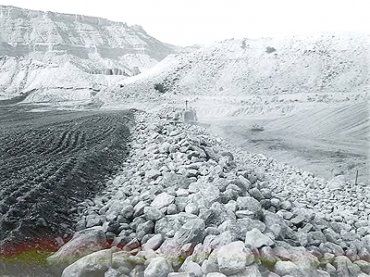A public meeting was held on the Millsite Dam Rehabilitation at the county building. The draft plan of the environmental assessment is ready for review. The comment period is open until Feb. 22. Millsite dam has been evaluated for several years and has moved up on the dam safety list and has gone from a low rating to a high rating on the hazard list.
Norm Evenstad said Millsite was part of the original watershed project. It was built back in 1971. This project would work to help slow the sediment from the watershed.
Eric Dixon explained that the materials used in the construction of the original dam could liquefy in the event of an earthquake.
Dixon said as part of the environmental assessment process they must consider rehabilitation as well as doing nothing as they developed alternatives. They started with scoping and are now in the draft EA. One alternative is no action; the other is taking the dam out of commission. If the dam is left as is, eventually the canal company will get a notice that they must breach the dam because it is potentially unsafe. Dixon said they have looked at a variety of alternatives. Sixty-five percent of the funding will come from the NRCS. Millsite was designed in the late 60s with a lot of big rocks. The draft EA end comment period ends Feb. 22.
The NRCS is looking at wildlife and biology issues. They have done survey work and plant work concerning the Threatened/Endangered species. They are working with the US Fish and Wildlife Service concerning the T/E. They are waiting on a statement from the US Fish and Wildlife.
Over the years with the sediment flows into Millsite Reservoir, the reservoir has lost capacity. It’s estimated 74 acre feet of sediment comes into the reservoir each year.
The spillway will be lowered 10 feet with the rehabilitation process. In looking at how the original dam was built, it doesn’t meet seismic criteria.
Dixon said with the materials used in the original Millsite dam, the top 15 feet could turn into mush. This will be replaced with compacted materials. The earthwork must be done before winter hits. The spillway removal can be done in the winter. The sidewalls must be up when spring hits so it can handle the spring run-off. Downstream slope excavation will take place late summer 2016; new berm-spring-summer 2017; downstream slope reconstruction summer/fall 2017; outlet works extension fall/winter 2016; foundation excavation and backfill fall 2016;
Hole three of the Millsite golf course will need to be reconstructed. The construction period will put hole 4 out of service during the construction time. It will be part of the construction zone. There are a lot of entities involved with the outlet works, there needs to be temporary connections to pass water for Ferron City, CVSSD and the power plant. The state park will be impacted because of the raised water level. The dam top will be flattened a little.
In 2017, some water will be stored in the reservoir; the irrigators won’t be without water during the construction period. They will work with dam safety to determine how much water can be stored in the reservoir.
The reservoir will be four feet taller. There will be a flip bucket to push water away from the cliff during spilling. The existing spillway can pass 12,000 cubic feet per second, with the rehabilitation it will have the capacity to pass 30,000 cfs.
The canal company can use in-kind costs for the match. Millsite is a long dam and will need a lot of rock. There’s not a lot of room to put the rock. The filter drain is expensive. A new bridge will need to be built over the spillway. Work at the state park will take place from October to March.
Contractors will need to go through a pre-qualification process. The project will need an experienced contractor; a company experienced in filters and drains. From this select pre-selected group the company can put together a bid. The bid will be out in April-May and early to mid-June the bid will be awarded and the work will be started in July 2016. After the comments come in the final draft will be issued in a month, out the end of March; it will hinge on the US Fish and Wildlife issuing an opinion.
This spring irrigators will be instructed to use as much water as possible. The NRCS will be working with the corps of engineers.
Dixon said the snowpack is good this year; they may speed up the draining of the reservoir a little bit to draw the water down a little faster than a normal season.
Tracy Behling from the Ferron Canal Company said this past fall they pulled the reservoir a little lower than usual. They will give a larger allocation of water and irrigators will be given a generous allocation. They will work to get the most good out of the water available.
You can access information and the draft EA on the NRCS website.
The NRCS hopes to stay off the BLM land and on the private land for the storage of the barrow materials. The project will raise the dam four feet, it will impact the cactus on the fringe of the reservoir.
The NRCS is in talks with the US Fish and wildlife Service as to what they want them to do to mitigate the cactus.
Installation cost estimate for the rehabilitation of the dam is $26,602,400 the design engineering cost is $2,671,400 and the administrative cost is $534,000 for a total of $29,807,800.
Millsite dam rehabilitation meeting open house

"Construction began on the Millsite dam in 1971."
